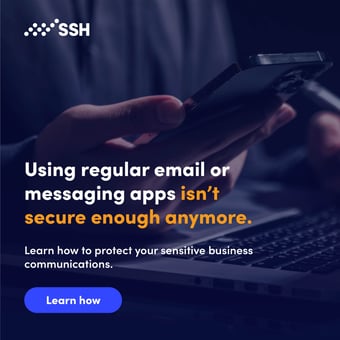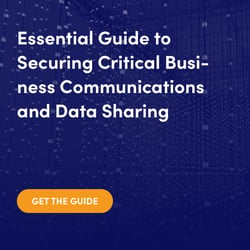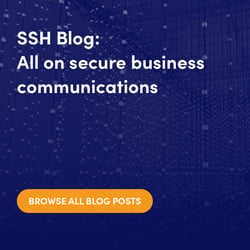How to secure your business communications using Zero Trust
Zero Trust is a common concept in cybersecurity these days. As a theoretical model, Zero Trust redefines how businesses think about and secure their IT environments – leaning away from perimeter security toward perimeter-less. The Zero Trust principle can also be used to secure your business communications.
Let's look at how you can implement Zero Trust for secure business communications in practice.
Contents
What is Zero Trust for secure business communications?
Why do you need Zero Trust to secure your business communications?
How to secure your critical business communications with Zero Trust?
SalaX Secure Collaboration: Your Zero Trust solution for secure business communications
What is Zero Trust for secure business communications?
In practice, Zero Trust means that the identity of all users and devices entering a network is validated. The next time they want to enter the network, their identity is revalidated again. Next time – another revalidation. And so on.
No user or device entering a network (or a perimeter) is trusted. Their identity is always verified and authenticated.
In the same manner of “never trust, always verify”, Zero Trust also applies to secure business communications. Especially when it comes to communicating and sharing sensitive information, like business secrets, financial data, or customer information.
Every user, whether the sender or recipient of a message, needs to be verified and authenticated – to ensure that the sender is a trusted source of information and that the message reached the right recipient.
Why do you need Zero Trust to secure your business communications?
 Modern IT environments are not static – similarly, modern business communications are dynamic in nature.
Modern IT environments are not static – similarly, modern business communications are dynamic in nature.
With remote work being the new standard and businesses collaborating and operating on a global scale, digital business communications are on the rise. Every business and employee needs to share information and data internally with other employees or externally with partners, customers, and third-party vendors.
Implementing the Zero Trust model and architecture for secure business communications is a way to protect your business against data breaches and leaks.
How to secure your critical business communications with Zero Trust?
Here’s a list of practical steps your business can take to improve the security of your business communications with Zero Trust:
Classify and control your sensitive data
Before you start implementing any security measures, you need to understand your data.
What kinds of data do you have and need to manage? Not all data is equal – some information is sensitive, highly restricted, or even secret. Where is your data? Some of your data might be on-premises on your own servers or in the cloud managed by a cloud service provider.
Especially in highly regulated industries (like healthcare or governments), certain data cannot be stored in the cloud.
Start by classifying your data according to your needs and relevant regulations and identify where it lives – this will help you specify your data security needs.
Verify users and restrict their access rights
As mentioned above, the Zero Trust model operates on the principle of never trusting anyone. So, verifying your users, whether internal or external, is a crucial process.
When your employees are sending emails, sharing sensitive information, or collaborating on restricted documents, their identities need to be verified to prevent unauthorized access. Similarly, you need to authenticate recipients of your sensitive emails or data.
Additionally, to prevent unauthorized modifications or sharing of your sensitive data, utilize access control levels. For example, some users may only view your data, but another group of users may input or edit the data.
Use strong authentication methods (such as multi-factor authentication, PIN codes, or SSO) and various levels of access rights to ensure that only the right users with the right level of access can view, modify, or share your data.
Secure your business email
The most common communication channel for businesses is email. Business email is also the most vulnerable and commonly targeted communication channel (common cyberattacks include business email compromise or email phishing).
Your employees regularly communicate and share data via email, which is fine as long as emails containing sensitive information are encrypted. If you don’t encrypt and secure sensitive email communications, your business is an untapped cyberattack vector. And it’s only a matter of time before you’re a target of a data breach.
Educate your employees about enterprise email security and encrypt your email communications whenever necessary.
Secure your data sharing and collaboration system(s)
Data sharing is simply a must.
Here are just a few reasons: organizations need to share data with their employees to enable remote work, data sharing is crucial for certain systems and apps to improve operational efficiency, and external vendors and customers require data sharing to be able to collaborate.
Start by implementing appropriate data-sharing tools and controls based on your data sensitivity levels.
For example, it’s possible and simple to share data over a commonly used tool like Google Drive. But is it secure?
Choosing the right tool or a set of tools with appropriate security measures will help you with the technical controls needed, like data encryption, authentication of users (e.g. MFA), or access rights control.
Secure other important business processes
Email communications and secure data sharing aren’t the only critical business processes – it’s important to identify and secure other channels that handle communications or data.
Examples of these business processes include e-signing of documents with digital signatures, data collection using online forms, or real-time messaging/calls and collaboration.
Utilize automation, monitoring, and audit trails
You can have all the tools, policies, and employee training in place – but mistakes happen anyway. Even nowadays, human errors are still the second most common cause of data breaches (causing 21% of all data breaches).
To protect your business (and your employees), implement automation wherever possible. For example, your business emails can be automatically scanned for sensitive or restricted information – when an email contains sensitive data, it can be automatically sent as a secure, encrypted email.
You can also get a full insight into who viewed or handled your data and communications with the right monitoring and auditing tools.
SalaX Secure Collaboration: Your Zero Trust solution for secure business communications
Our SalaX Secure Collaboration is a Zero Trust communications and data encryption software designed to secure the most critical business communications and processes. SalaX Secure Collaboration is a collection of applications that help organizations, their employees, and external collaborators access, verify, sign, receive, store, and share sensitive data in an extra secure and compliant manner across organizational borders and when working with external stakeholders.
With SalaX Secure Collaboration, your data and communications are protected by robust end-to-end encryption, and Zero Trust security is supported by various authentication methods (including MFA, PIN, SSO), audit trails, and reporting options.
Learn more about SalaX Secure Collaboration >>>
Related content:
Maarit Asikainen
Maarit Asikainen is business manager with strong background in software and IT industry. She has worked with major companies like Nokia, Telia and EVRY in marketing, sales and business development roles. She believes that the interplay among strategy, offering, brand, and customer understanding ultimately fuels the...



